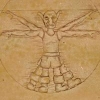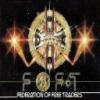world maps
It is hard to answer, but I got two favorites: Elder Scrolls II: Daggerfall and Bard's Tale I . If you take a look at the games you will wonder why not oblivion or skyrim. The reason is the following:
Bard's Tale I had a mini world map, just a single town with only a few usable buildings, and every single usable building had some use. Daggerfall on the other hand had a large, procedurally generated world which delivers a generic, still living world.
When I play a RPG, I dont need all this story threads, and mindless talking about the common gossip. Modern games try to go into great details, but on the other hand they need to reduce the overall scale so much, that it is often cluttered with non-functional blah-blah and really small scale on the other hand. The result is often that you encounter villages with 5-10 villager, a dark castle, which is just 20 meter down the street, goblin hords consisting of 4 goblins and dungeons which are as small as your common medieval cellar.
Eventually, in my opionion, a world should be large and a game should be functional and consistent. I don't need a detailed, unbelieveable world simulation, when it comes at the costs of really small scale.
I'm inclined to agree with powerneg: design the map or overworld that suits your game. I don't believe that there is one universally-applicable design for the world map or overworld. For two examples, do you want random encounters in the overworld? Then you probably want an overworld that the player travels manually, or that at least shows progress on the map. On the other hand, if the player is going to be travelling back and forth a lot then it might be better to simply "teleport" the player to the selected location.
MWAHAHAHAHAHAHA!!!
My Twitter Account: @EbornIan
just something that can give people a good general idea to use as a seed for their own unique worlds. I would like to note that one of the admins of the gamedev.net facebook page mentioned the world map from baldur's gate 2 as an example of one of the ones they thought worked really well.
The thing is, no attributes occur to me--beyond general UI design, which applies rather more broadly than just maps and overworlds--that apply to any given game. The attributes that make one map good for its game might make it a poor choice for another.
I would like to note that one of the admins of the gamedev.net facebook page mentioned the world map from baldur's gate 2 as an example of one of the ones they thought worked really well.
But would that map work as well in, say, Infamous: Second Son, or Zelda: A Link to the Past--or at least better than the solutions that they used?
MWAHAHAHAHAHAHA!!!
My Twitter Account: @EbornIan
I don't know if there are agreed-upon anything, but here's my take.
An "open" map where I can explore all I want (that is, an "overworld") should really reward the time I spend in traversal; there should be lots of things to find and rewards for doing so. (Whether the "reward" is a new quest, or something valuable, or just "hey, that's an interesting thing on its own".) On the other hand, if you've got a very lock-and-key world where the game is "plot increment, find the next correct spot on the map, repeat", then I'd rather *not* have the illusion that I'm supposed to be exploring. It's a bit of a bait-&-switch: a big world full of findable places, but all the places but one are "Oh, sorry, this bridge is being repaired."
I just played Steve Jackson's "Sorcery!" and I quite liked the honesty of the world map traversal. The structure of the game is a choose-your-own-adventure, and the map doesn't hide that. If you have two options, there are two places you can move your character to; if you have five options, there are five places; if you have one option, there's one place.
Anyway, my principle is that a world map should honestly represent the freedom available to the player.
I agree that the map should reflect what is open to the player and should refrain from showing things that are not available for access. And that is the kind of input i had in mind.
Well, that's general user interface design, I suppose--it's not really specific to maps.
Another such point might be to clearly differentiate interactive objects/icons/etc. from background elements: don't make interactive elements that are lost in the backdrop, and don't make backdrop elements that appear to be interactive.
MWAHAHAHAHAHAHA!!!
My Twitter Account: @EbornIan
Also use a level of detail system.
Take a look at any of the Assisin's Creed franchise. They use fixed size icons for everything, so when you zoom out, it's impossible to find what you are looking for.
You can spend ages zooming in, zooming out moving the target, zoom in again....
They know it's an issue as they allow you to turn off icons for groups of items, but it's clunky and horrible.
IMHO when you zoom all the way out, only the main quest should be visible and you gradually introduce other types as you zoom in.











